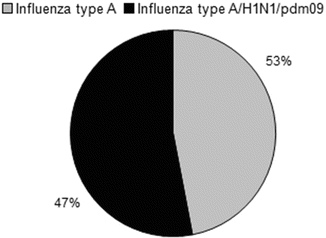Fig. 1
Infections caused by influenza and influenza-like viruses causing respiratory disease in Poland in 2010–2011 epidemic season; investigated within the I-MOVE project
The results show that influenza and other respiratory viruses are a major clinical, virological, and epidemiological problem. In the samples from the epidemic season of 2010–2011 in the I-MOVE project, the presence of the genetic material of influenza virus type A and B was detected in 81 cases, which represented 38.6 % of all samples investigated; the share held by the influenza virus type A/H1N1/pdm09 is shown in Fig. 2. In the remaining 71 positive samples, i.e., 33.8 %, the following respiratory viruses were detected: Human parainfluenza virus type 1–4, Human respiratory syncytia virus type A and B, Human coronavirus 229E/NL63 and OC43, Human rhinovirus type A, B, and C, Human enterovirus, and Human adenovirus.


Fig. 2
Infections caused by influenza A non-subtype and influenza A/H1N1/pdm09 in Poland in 2010–2011 epidemic season; investigated within the I-MOVE project
In 23 (11 %) cases, a co-infection with two respiratory viruses was reported, which constitutes a serious clinical problem because of the lack of suitable, effective antiviral drugs. The neuraminidase inhibitors, such as oseltamivir and zanamivir, are suitable only influenza treatment. These drugs are not effective in preventing infections caused by other viruses in the respiratory system. The arrangement of co-infecting viral pairs detected is presented in Table 1.
Table 1
Respiratory virus co-infections
Type of co-infection | Positive samples |
|---|---|
Human parainfluenza virus 2 | 1 |
Human respiratory syncytial virus B, Influenza B | |
Human coronavirus 229E/NL63 | 1 |
Influenza A | |
Human rhinovirus | 4 |
Human respiratory syncytial virus A | |
Human respiratory syncytial virus A | 1 |
Influenza B | |
Human parainfluenza virus 3 | 1 |
Human coronavirus OC43 | |
Human parainfluenza virus 3 | 1 |
Human rhinovirus | |
Influenza A | 1 |
Human parainfluenza virus 4 | |
Human adenovirus < div class='tao-gold-member'>
Only gold members can continue reading. Log In or Register to continue
Stay updated, free articles. Join our Telegram channel
Full access? Get Clinical Tree
 Get Clinical Tree app for offline access
Get Clinical Tree app for offline access

|